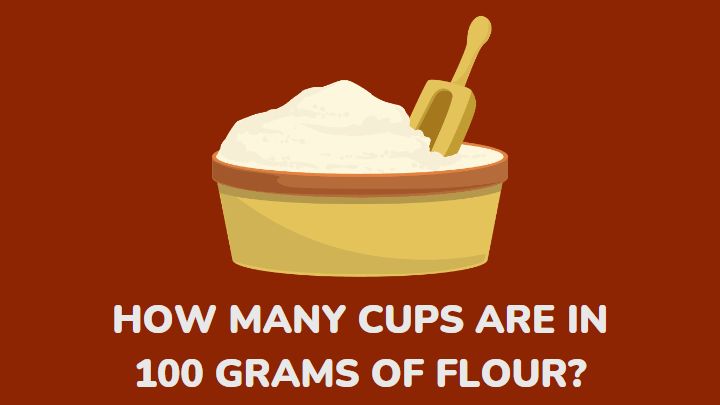Are you wondering how many cups are in 100 grams of flour?
Recipes are written differently. One recipe may with grams or kilogram measurements and the another may require that you measure with a cup. Moving across these two different measurements may not always be easy.
If you always find it difficult or you’re currently looking at a bowl of flour but don’t know what next to do, I got you covered.
How many cups are in 100 grams of flour?
100 grams of flour contains half a cup and 2 tablespoons of flour.
How many cups are in 100 grams of almond flour?
1 cup of almond flour is equivalent to 100 grams.
Almond flour is a healthy flour gotten from almond fruits. You can make it at home by processing blanched almonds in a blender and blitzing them to a fine powder.
How many cups are in 100 grams of rice flour?
100 grams of rice flour is less than a cup but more than half a cup.
How many cups are in 100 grams of all-purpose flour?
100 grams of all-purpose flour is less than a full cup but more than half the cup. It is the same amount for plain and self-rising flour.
Why do you need to measure flour?
Flour measurement largely determines the outcome of your meal. Too much or too little flour can ruin what should have been a great meal.
Too much flour can make baked goods hard and dry. Similarly, too little flour will not make them hold together.
Therefore, you need to measure flour correctly to get your recipe right.
Why do you need measuring cups?
A measuring cup is a kitchen utensil used to measure the volume of liquid or solid ingredients. The cups work for quantities from about 50 mL (2 fl oz) and above.
You can also use measuring cups to check the amount of liquid and powder materials. You need measuring cups to measure flour, milk, and water.
How to measure flour with measuring cups
1. Fluff up the flour in the bag or canister
Allow the flour to settle smoothly while tightly packed inside the bag or jar. To ensure you are not scooping up packed flour, you should fluff it up with a spoon or fork. Do this before you start measurement.
2. Pour a ladle of flour into the measuring cup
Gently pile it in until you see a heap about the rim of the measuring cup. Do not pat the flour down.
3. Fill the flour
The next thing to do is to fill the flour and then scrape your knife across the top of the measuring cup. Do this to level the flour to get rid of excess flour on top of the cup. Ensure you level the flour without packing the flour inside.
4. Measure your flour
Do not scoop the flour directly from the canister. The flour usually gets densely packed when you dip the measuring cup. Dip the cup in so it does not yield too much flour.
For reference, less than one cup of spooned and leveled all-purpose flour should weigh 100 grams. In contrast, if you scoop and pack a full cup, it can weigh up to 155 grams.
If a recipe calls for a cup of flour, you could take up as much as 1.25 times more. The 1.25 difference will have a massive effect on your baked goods’ turnout.
Weighing your flour is invariably the easy way to go. However, if you don’t have a scale, spooning the flour into a measuring cup and balancing it with a knife is your next reasonable chance.
Is a measuring cup the same as a regular cup?
Yes, you can. Largely, a measuring cup holds the same quantity as a regular cup. But, the regular cup should be the same size as the measuring cup.
FAQs
Should you measure or weigh flour?
Flour measurements can be a substantial variable when it comes to the finished product in confectionery. So weighing ingredients is your safest bet. It is by far the most accurate method of measurement.
Why is measuring flour so important?
Baking is a science that requires accuracy. Measuring flour is vital to get that perfect result every time.
What do you do if you don’t have a measuring cup?
You can use a kitchen scale. The kitchen scale will be helpful for you to cook or bake without a measuring cup. You can also measure with regular cups.
Is the wet cup the same as the dry measuring cup?
Yes, it is. Both measuring cups hold the same volume, but they have different roles. Each cup is specifically designed to accurately measure its respective ingredient.
Should you sift flour before measuring?
The recipe determines if you sift flour or not. But, you must always sift before you measure. Otherwise, you may have less flour than required.
If your recipe requires sifted flour, sift the flour.
Conclusion
Measuring flour is a critical detail. When something in your recipe does not turn out right, the first question that comes to your mind “how did I measure the ingredients?”
The right or wrong measurement will affect your baked food dramatically. You have to be intentional.
Thank you for reading.
For more related articles on conversions and measurements, visit Millenora.

